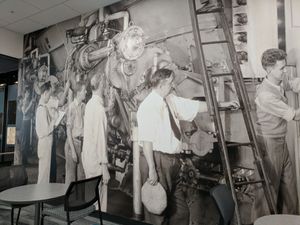I was interested to come across this passage in a presentation [ppt] about library strategy by Dr Paul Ayris of University College London:
Challenges
- Identifying the needs of UCL researchers and students, and recognising the most appropriate tools to meet these needs
- Fitting such developments into an electronic world which now focuses work not on the local level, but at the network level
As regular readers know, ‘network level’ is a favorite expression of mine. This question is interesting because of the transition we are working our way through. Libraries tend to be institution-scale in reach as they were organized as a pre-network response to information management. In that context, institutionally based services make sense. For example, information materials were acquired and made available to the local population on a just-in-case basis. The institution remains the appropriate scale for many activities. However, researchers may now be drawn to newer network level approaches which aggregate supply and/or attention across the network, or across a discipline .. think for example of initiatives like ICPSR, SSRN, Repec, Arxiv or more generally of Google Scholar or Twitter. At what scale will researchers look for applications to do their work – institution, collaborative group, discipline, network? Where does it make sense to let services be provided by external network level providers and where should the library provide services? There is no right answer of course, and practices are shifting.
Think of some directions ….
- Discovery. Discovery happens elsewhere: in Google, in Google Scholar, in Arxiv, in Mendeley, in Twitter, …. This has resulted in two broad directions. One, to create single-search access to broad data wells, so-called discovery layers solutions. Two, to think about how to syndicate library resources into other environments through APIs, data sharing or other approaches. Think of the find-in-a-library link in Google Book Search or the work Google Scholar has done with institutional resolvers. One of the reasons I so much liked the recent University of Minnesota report on discovery is that it takes this wider environment as its problem area. It considers how the library supports effective discovery of its resources in an environment of multiple discovery services, some institutional, some external network level services.
- Citation management. A library may have provided support through an institutional subscription to Endnote or Refworks. More recently, faculty and students may use network level approaches such as Zotero, Mendeley and EasyBib. These approaches have their own characteristics and what we are now seeing is libraries move to provide support or advice across tools they subcribe to and those they don’t. See for example the MIT libguide on citation management, their pages for Zotero, Endnote and Refworks, which they support, and a general overview of some other tools which may be useful.
- Expertise/researcher profiles. Various universities are interested in disclosing details of faculty research, grants, publications, areas of expertise, etc, and there are some elaborate approaches to this which may or may not be well integrated with CRIS or institutional repository systems. Of course, individuals will also potentially manage other network identities, within social networking environments, in professional societies, and so on. And product support for this kind of activity is emerging. Again, there will be multiple such activities and it poses interesting questions about incentives and roles.
- Deposit of research outputs. There are both institutional and network level venues for deposit and management of papers or data.
These comments are prompted by reading a report recently released by colleagues of Paul Ayris at UCL, the Ciber group, and Emerald Publishing: Social media and researcher workflows [pdf]. The research group received responses from 4-6% of a large target list, and acknowledge that the survey was deliberately aimed at those with an interest in social media. With that qualification, here are some of their findings ….
1 Social media have found serious application at all points of the
research lifecycle. The three most popular social media tools in a
research setting are those for collaborative authoring, conferencing,
and scheduling meetings.
8 The most popular tools used in a professional research context tend
to be mainstream anchor technologies or `household brands’, like
Skype, Google Docs, Twitter and YouTube. Researchers seem to
be largely appropriating generic tools rather than using specialist or
custom-built solutions and both publishers and librarians need to
adapt to this reality. Is this a sign, perhaps, that there may be a gap
in the market for simple bespoke tools?
9 The key driver for the take up of social media is pressure exerted by
peers outside of the researcher’s own institution. Social media are
helping to fulfill the demand for cheap, instant communication
between researchers fuelled by the growth of collaborative and
interdisciplinary research.
10 Use of social media is usually down to personal initiative, so a clear
understanding of the capabilities and benefits of these tools is
essential. Time-poor researchers are still unclear about the benefits
of social media and this represents a major barrier to their take up.
They also have serious concerns about the authenticity of crowdsourced information.
11 Users and non-users of social media express almost identical
preferences when they look for scholarly information. Their first
preference is for the open web, followed by searching licensed econtent through their libraries, followed by asking a colleague. The
only difference we could detect in this survey between users and
non-users is that the former are more likely to put out a general call
for information on a list serv or social network.
12 We find a similar pattern with regard to research dissemination. The
traditional channels (especially journals, conference proceedings
and edited books) are greatly and equally favoured by both social
media users and non-users over informal channels such as blogs.
Researchers continue to back dissemination routes that they know
and trust. It is clear that social media users see informal tools as a
complement to the existing system of scholarly publishing, not as a
replacement. As a result, personal dissemination is on a steep
upward curve, with implications for publishers especially.
13 Researchers, especially senior researchers, want above all for
publishers to make content readable on all platforms. This, together
with more progress in linking articles to their underlying data. They
want the basics to work well, not more `bells and whistles’.
14 Researchers also sent a clear message to librarians. At the top of
their wish list, and by a big margin, is a desire to be able to search
across the full text of all locally-held licensed e-content using a
simple interface like Google. This is seen as a much greater
potential benefit than libraries moving into the social media space
by offering users, for example, an opportunity to socially tag the
library catalogue.
Interestingly, the authors did not include citation management in the survey. They also have a methodological note which should be consulted.
In the last few years we have seen many studies of this type – some from OCLC – which talk about researcher, student and general consumer behaviors. I think that in many of them one can see this scale question for the library. Quite often, the response is that the library should look more like these network tools. I believe this is a mistaken or at best a partial response, although some updating is useful. A more appropriate response is to consider library resources in the context of this overall environment. So, research support may provide advice and guidance on a range of tools and services not provided within the library itself. Consideration may be given to making sure that library resources are visible in important discovery venues, making sure that the institutional link resolver is properly configured for Google Scholar access for example. Images may be put on Flickr, links to special collections added to Wikipedia, videos put on Youtube or iTunes, presentations put on Slideshare, and so on. Deciding where to invest energy becomes an ongoing task.
Update: edited to restore the balance of a mistakenly truncated sentence. 3 March 11.



